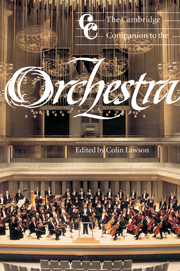Book contents
- Frontmatter
- 1 The history of the orchestra
- 2 The development of musical instruments: national trends and musical implications
- 3 The orchestral repertory
- 4 From notation to sound
- 5 The art of orchestration
- 6 The history of direction and conducting
- 7 International case studies
- 8 The revival of historical instruments
- 9 Recording the orchestra
- 10 Training the orchestral musician
- 11 The life of an orchestral musician
- 12 Historical recordings of orchestras
- 13 The orchestral composer
- 14 Educational programmes
- 15 The future of the orchestra
- Notes
- Appendices
15 - The future of the orchestra
Published online by Cambridge University Press: 28 September 2011
- Frontmatter
- 1 The history of the orchestra
- 2 The development of musical instruments: national trends and musical implications
- 3 The orchestral repertory
- 4 From notation to sound
- 5 The art of orchestration
- 6 The history of direction and conducting
- 7 International case studies
- 8 The revival of historical instruments
- 9 Recording the orchestra
- 10 Training the orchestral musician
- 11 The life of an orchestral musician
- 12 Historical recordings of orchestras
- 13 The orchestral composer
- 14 Educational programmes
- 15 The future of the orchestra
- Notes
- Appendices
Summary
Introduction
The symphony orchestra is undoubtedly one of the great cultural achievements of European civilisation. It is also one of Europe's most significant cultural exports. What began as relatively small collections of musicians in the courts of central Europe in the seventeenth century has not only grown in size but also achieved a wide geographical spread. Indeed, the orchestra is now a truly world-wide phenomenon, and such globalisation can largely be explained as a result of two significant factors. First, European expatriation in the nineteenth and early twentieth centuries, whereby migrant communities from various European countries settled elsewhere, inevitably resulted in the transplantation of numerous aspects of European culture; Western art music and its most significant ensemble, the symphony orchestra, were invariably part of this process. Second, as Western culture generally and its music in particular became more widely disseminated, helped later by the growth of the recording industry and the global domination of a small number of Western record companies, Western art music achieved a degree of popularity – and sometimes cultural ascendancy – in areas where it was not part of the indigenous culture. Along with Western-style institutions of music education (conservatoires and exam boards, for example) the symphony orchestra became seen as an acceptable, even desirable, organisation, for rather complex and variable reasons relating to local cultural and political aspirations.
- Type
- Chapter
- Information
- The Cambridge Companion to the Orchestra , pp. 251 - 264Publisher: Cambridge University PressPrint publication year: 2003
- 4
- Cited by



